Day 11, Friday March 18 :
A couch holding art books, in one of the alcoves on the ground floor was converted into my bed for the night. Soon after I'd covered myself with a shredded blanket George's infamous black cat appeared out of nowhere, and plopped itself on my chest. With lots of coaxing I got it to move down into a space against my legs where it stayed for the rest of the night. This cat is very greedy and must be the heaviest cat in all Paris. If it sees something edible in the hands of a customer sitting on the benches before the store it will pounce on him and steal as much food as it can get away with before being chased off. Here is a picture of this cat taken 6 years ago.
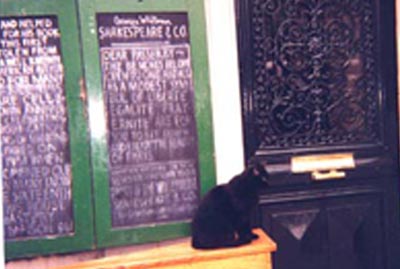
I arose around 7 AM; light was pouring in from the large display windows in the front room. I dragged out my suitcases and spent an hour or so organizing clothing and other personal items. The light rain when I left the store at 8 dissipated within the hour.
For breakfast I stepped into a café in the plaza to the right of the old buildings of the Sorbonne on the Boulevard St. Michel. The headwaiter, imagining he had some dumb American tourist on his hands, tried to persuade me to sit at a table on the terrace where he would bring me a grand café crème . He was dumbfounded when I tolf him that I was perfectly aware that prices could double if one sat in the terrace and that all I wanted was a smallcafé crème at the counter . Three men standing further along at the counter burst out laughing; it was more than obvious that the waiter had intended to take advantage of my hypothesized ignorance. They gave him quite a hard time; I don't think he appreciated it very much. There's lots of money to be made in Paris through capitalizing on the ignorance of tourists.
By 10 AM I was ready to take in the principal event of the day: participation in the International Book Fair ( 25ème Salon du Livre ) at the enormous convention center located at the Porte de Versailles metro station. Through studying the map of Paris outside the metro station Luxembourg , it appeared to me that the easiest way to get to the Porte de Versailles metro station was via a direct connection at the station Notre- Dame des Champs .This was correct, but what I didn't realize was that , although the rue Notre-Dame des Champs begins a short distance away from the Luxemburg Gardens at the juncture of the Boulevard de Montparnasse with the rue de Port-Royal, the metro station is at the other end, a distance of 2 miles or so!
Walking around Montparnasse I didn't see any sign of the station Notre Dames des Champs. I decided to cross the wide expanse of the Boulevard St. Michel to get some information at stationPort Royal , a large metro station situated on a traffic island. This nearly got me killed. The lights changed as I was in the middle of the wide boulevard, and all the vehicles across the Boulevard de Montparnasse above me to my right, set off instantly in high gear. One individual on a motorbike appeared to be fleeing some vision from hell; he aimed himself directly at my fleeing shape. Despite my abstaining from religious affiliations, I could not control myself from screaming out the famous name of the prophet of the dominant religion in the Western world. Obviously I survived the crossing or I wouldn't be writing about it.
The joker behind the ticket window at Port-Royal didn't know how to get to the Notre-Dame des Champs metro station. He insinuated that there was no such station; his supervisor corrected him. Then he suggested that I board the RER at Port-Royal and transfer, an extremely complicated operation involving much negotiation between the RER system and the old metro lines which could take up as much as an hour of my time . I mentioned to him that a street called Notre-Dame des Champs was about a block away. "Oh well, so its there then" he said, shrugging his shoulders as if to indicate that the interview was at an end. I went back to the rue Notre-Dame des Champs and began walking.
After a mile or so immersed in the charm of this narrow and twisting street, I began to despair of ever finding its metro station. Then I ran into a pair of lycée students. One of them, a young man pointed down the street. "Just keep walking. Its all the way at the end." I mentioned to him that the vendor behind the ticket booth at Port-Royal didn't know where the station is located. "Certainement " he replied, "ils sont nuls!" (They' re dopes).
Eventually I did find it. Ironically, it's actually only a short distance from the Jardins du Luxembourg , but at the other end, near the Boulevard St. Germain. I might have saved myself a walk, but there would have been no story.
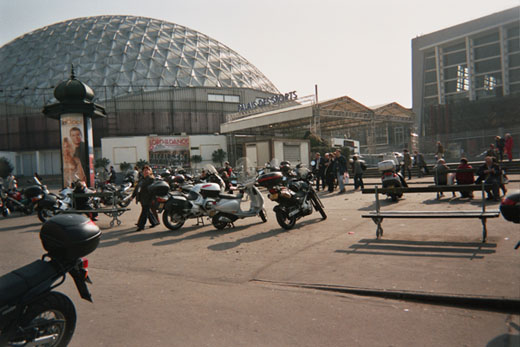 The station was crowded. It looked as if the entire city was going to the book fair (which may have been the case. In Paris a book fair is an event! ) At Porte de Versailles the crowd encountered lines of young people extending from the station to the entrances of the convention center, handing out advertising brochures, book marks, and other advertising from the publishers at the fair. I picked up several copies of a tiny "booklette" (sik! ) roughly the size of a thumb-nail. Vos droits fondamentaux , printed by the Socialist Party,contains the complete text of the EU Constitution which would be put to the vote on May 29th. As we now know, the constitution was rejected.
The station was crowded. It looked as if the entire city was going to the book fair (which may have been the case. In Paris a book fair is an event! ) At Porte de Versailles the crowd encountered lines of young people extending from the station to the entrances of the convention center, handing out advertising brochures, book marks, and other advertising from the publishers at the fair. I picked up several copies of a tiny "booklette" (sik! ) roughly the size of a thumb-nail. Vos droits fondamentaux , printed by the Socialist Party,contains the complete text of the EU Constitution which would be put to the vote on May 29th. As we now know, the constitution was rejected.
Security guards were posted at all the entrances to the convention center. After the search of my shoulder bags I was allowed to enter the building. Screens blocked entry into the main area of the conference, with openings for the public and for journalists. Needless to say I went to those for the journalists . Two things worked in my favor: the business card of Ferment Magazine, and the large "No War" button that I'd pinned to my jacket and wore at all times while travelling around France. A woman was seated on a high stool off to the side; she was satisfied with the business card and let me in . I still needed to be given an official invitation from the women sitting in a booth on the other side of the screen . They had no trouble with my card; however, as I was not officially registered as a journalist for a French publication, they would not give me a "badge". All the same I was given a complimentary "invitation" , and a complete press kit! They neglected to tear off the stub attached to the invitation and I was able to use it again when I returned the next morning.
Salon du Livre
Porte de Versailles, Paris
March 18th and 19th
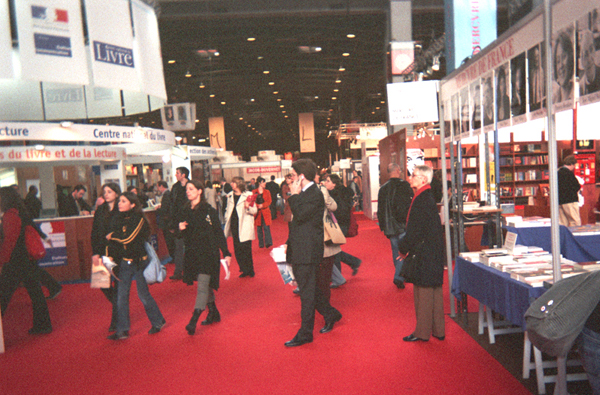 The Porte de Versailles convention center sits inside a gigantic Buckminster Fuller dome. Garish red carpeting covers its enormous floorspace like the upholstery in a small-town movie house, intensifying the cavernous gloom implicit beneath its high ceiling. The hall was densely seeded with stalls, tables, displays, and bookshelves for representatives from more than 1000 publishers, large and small. The French publishers, which were in the majority, were placed, either by region or subject, on a 14x14 section grid of aisles identified by numbers or letters of the alphabet. Sections were set aside for international contingents, Italian, Russian, etc. and for science publishers, publishers of theater books, art books, and so on.
The Porte de Versailles convention center sits inside a gigantic Buckminster Fuller dome. Garish red carpeting covers its enormous floorspace like the upholstery in a small-town movie house, intensifying the cavernous gloom implicit beneath its high ceiling. The hall was densely seeded with stalls, tables, displays, and bookshelves for representatives from more than 1000 publishers, large and small. The French publishers, which were in the majority, were placed, either by region or subject, on a 14x14 section grid of aisles identified by numbers or letters of the alphabet. Sections were set aside for international contingents, Italian, Russian, etc. and for science publishers, publishers of theater books, art books, and so on.
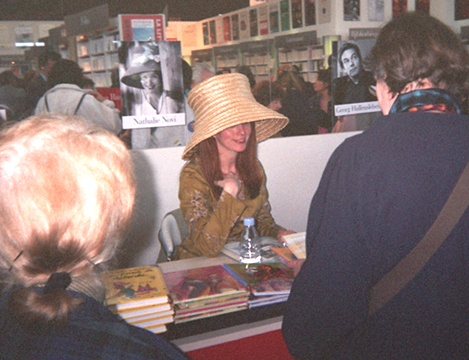
A writer of children's books.
The star attraction of the Salon du Livre was the Russian delegation, including 41 prominent authors, almost all of whom have emerged after the onset of Glasnost in 1989. An entire pavilion had been erected to hold them, including sections holding books by French authors in Russian translations, religious books, books for French students of Russian, a cafe-multimédiatique playing CD's in Russian, French and English, and a display of books from the famous Voltaire collection in the National Library in St. Petersburg. Finally there were bookshelves holding 5,000 French translations of works by classical and contemporary Russian authors.
Representatives of publishers from Italy, South America, Germany and other nations were present. There was no American delegation, nor delegations from any English-speaking country except Canada, which promoted French-language publishers from Quebec. There were several obvious reasons for this, one of them being that the ubiquity of the English language.
In addition to the usual stalls and stands of book publishers, forums, meeting areas, and performance spaces had been set up around the hall. These included:
(1) Le Carré des Arts : an exhibition space for graphic artists and display area for their artbooks
(2) L'Escale B.D. (Bandes Dessinés): Cartoon art is treated as a serious artistic medium in France. Several popular comic strip artists were on hand to meet with the public.
(3) Le Planète Virgin Ados : a place for adolescents between the ages of 12 and 17 to socialize, with poetry readings and other events.
(4) Le Forum : Panel discussions were scheduled throughout the day bringing together authors, publishers and officials from literary organizations A particularly interesting one featured 4 of the Russian novelists and was moderated by a translator.
(5) La Scene des Mots : A section had been set aside for publishers of theater books. Going beyond that to the far wall one came upon a stage and rows of parallel benches holding spectators. When I arrived an actor from the Theatre de la Ville was discussing his one-man show adapted from Dostoyevsky' s Dream of a Ridiculous Man . He also performed an except from the production . Later that afternoon I returned to attend a most vehement rendition of Boucles d' Or et les trois ours : (Goldilocks and the 3 bears) performed by a woman story-teller.
(6) Lecture-marathon de Don Quichotte : A recitation, from 11 AM to 6 PM, spread over 3 days. of Don Quixote in French translation by "Bruno Deniel-Laurent and his accomplices." !!
(7) Le Bar des Sciences : All of the science publishers were grouped together in a number of aisles at one corner of the hall. One encountered the "Bar des Sciences" when entering this area. Sponsored by Le Monde and other journals, it featured panel discussions with science writers and award presentations to young students.
At my first visit there 3 writers were sharing their experience of the difficulties of writing about on-going research. It's relatively easy to write books about evolution or particle physics or medicine, summarizing what is known. Transmitting the atmosphere mixing fascination and confusion generated by current theories, hypotheses, experiments in progress, and debates in the journals, is far more difficult.
After the panel was finished, the science editor of Le Monde read off the names from a list of high school students who'd won prizes for science projects they'd entered into a newspaper-sponsored Science Fair. It resembled what one finds in similar events in the US: shy, bright kids standing up and explaining in a few self-disparaging words the significant of their projects and their awesome consequences for the future of mankind.
After leaving the Bar des Sciences I made the rounds of the publishers of books about science for the public. I left samples of my biographical studies of Emilie du Chatelet, Alexandr Volpin, Grothendieck, Einstein, René Thom and others, and a number of book proposals. One of the stands displayed two rows of copies of a magazine calledFusion . The lead article was about Leibniz, so I remarked to a person standing there who could well have been a young engineer on his day off, that there is material about Leibniz's physics in my study of Emilie du Chatelet. He exchanged a copy of the magazine for a copy of my Chatelet essay. When I opened it that evening in Shakespeare and Company, I realized that Fusion is the official screed of the Lyndon LaRouche political movement in France! The trajectory that sent it into the trash basket was given a high initial velocity.
Materials were left with with Dunod , the magazine Pour la Science , Springer-Verlag , the publications division of CNRS , and the Presses Universitaire de France . The chances that anything will come from all this ridiculous and futile activity are vanishingly thin, but its amazing how much fun I had. I was doing what real writers do, in one of the few countries that still believes in the Republic of Letters.
I did however get a "feeble response of genuine interest" from a Russian publisher. Most of the Russian delegation, publishers, writers and book displays, was stationed in the Russian pavilion maintained by the giant bookstore conglomerate Gibert Jeune in the northeast corner of the convention center. There I was managed to talk with a representative, Sergey Obukh, of a Russian publishing house, Pilgrim Books.
To them I proposed a biography of the life and work of the famous civil rights activist and logician , Alexander Yesenin-Volpin, living in the Boston Area since the 1970' s. Sergey greeted the idea with cautious enthusiasm tempered by professional skepticism: market research would have to be done to find out if such a book could generate enough interest to be profitable.
Yesenin-Volpin isn't Martin Luther King, Jr. of course, yet his role in the Russian Civil Rights movements of the 60's and 70' s was very important, and I found it odd, though not surprising , that a publisher would only be concerned with the number of copies he might expect to sell. Clearly the Russians, in a little more than a decade, have been quick to pick up on the American model : best-sellers and cookbooks .
Returning that evening to the Bar des Sciences I listened to the author of a book about contemporary developments in Evolution. The moderator, another editor from Le Monde, was asking him : "But, sir, are you really claiming that Man is little better than a monkey?" Replied the author, with a mischievous grim: "That's exactly right. We're just monkeys."
I laughed. Members of the audience turned around and stared at me with astonishment: 'Who's this guy?' One doesn't laugh, even at the witticisms, of a serious scientist !
Altogether I must have spent 6 hours at the Salon du Livre between Friday and Saturday. Now, when people ask me why I went to France, I tell them:just business.
I left the book fair at around 3. George Whitman had told me that there were public showers in the neighborhood of his bookstore. Andy, a student from the US sitting at the cash register, thought he knew where they were on the Ile St Louis. The directions he gave me were a compilation of random misinformation. After half an hour of searching ( in which I visited several charming venues on the Ile St Louis and Ile de la Cité) I returned to Shakespeare and Company.
None of the other tumbleweeds knew where the public showers were located . Gemma , the cute girl from Australia, suggested that I ask the nuns in the vicinity of Notre-Dame ! I told her, ( with some exaggeration), that I never talk to people like that. After 3 searches, (including a nasty encounter with a French policewoman)
Much pleasanter policewomen
I finally located the public baths and showers off the Quai de la Tournelle - only to discover that they're closed on Fridays! If I didn't want to pay 5 Euros ( $7 !) for a shower at the Gare de Montparnasse, it would have wait until Monday. Gemma carefully copied down my precise directions to the public showers so that residents of the Tumbleweed Hotel would not have to waste an hour and a half that I did looking for them.
From this I conclude that the staff of Shakespeare and Company don't go in for showers very much. However that evening Deborah came by the bookstore and provided me with reliable directions to the public showers at the Place Contrescarpe. I went there the next morning. The establishment is everything a public shower can hope to be, and is completely free. One must supply one's own bar of soap and a towel. I hadn't thought to bring a towel alone and had to improvise with my shirt and trousers. The public baths at Contrescarpe are open on the days that the ones on Ile St Louis are closed, so one can always be confident of a free shower in Paris.
March 20th, Palm Sunday:
The Shakespeare and Company cat had been out on the streets all night long and was screaming to get back into the store when I looked out the windows at 7:30 in the morning. I had to go up to the second floor, stepping over several recumbent bodies on the way up, and open the door to the hallway. It scurried inside and immediately disappeared. Later the residents told me I didn't need to be concerned: the cat frequently stays out nights. However George asked me to see to it that the cat was in by midnight.
 Most of the cafés in the Latin Quarter are closed on Sunday mornings. The ones that were up and running were expensive. Luckily I discovered a place that would become my source of morning coffee for the remainder of my stay in Paris: the Columbus Café on the rue Soufflot, a short distance above the McDonalds that stands at the confluence of Soufflot, Gay-Lussac and St. Michel and directly across from the Jardins du Luxembourg. It offers a diverse selection of coffees at reasonable prices, doesn't distinguish between terrace and counter prices, claims to promote "free trade" products and ( very much on the lines of its American models) even prints out one of those damn "Mission Statements " on its receipts!
Most of the cafés in the Latin Quarter are closed on Sunday mornings. The ones that were up and running were expensive. Luckily I discovered a place that would become my source of morning coffee for the remainder of my stay in Paris: the Columbus Café on the rue Soufflot, a short distance above the McDonalds that stands at the confluence of Soufflot, Gay-Lussac and St. Michel and directly across from the Jardins du Luxembourg. It offers a diverse selection of coffees at reasonable prices, doesn't distinguish between terrace and counter prices, claims to promote "free trade" products and ( very much on the lines of its American models) even prints out one of those damn "Mission Statements " on its receipts!
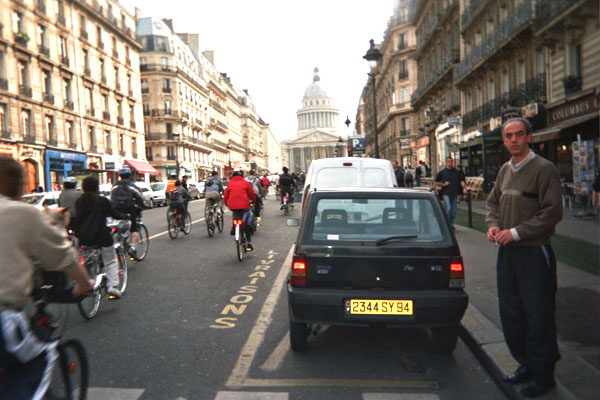
The broad rue Soufflot stretches downhill a third of a mile from the Pantheon to the Jardins du Luxembourg. I was both surprised and amused to see that both sides of the street had been covered over with long rows of turf patches cut into long oblongs, carpets of grass grown on a base of mud.
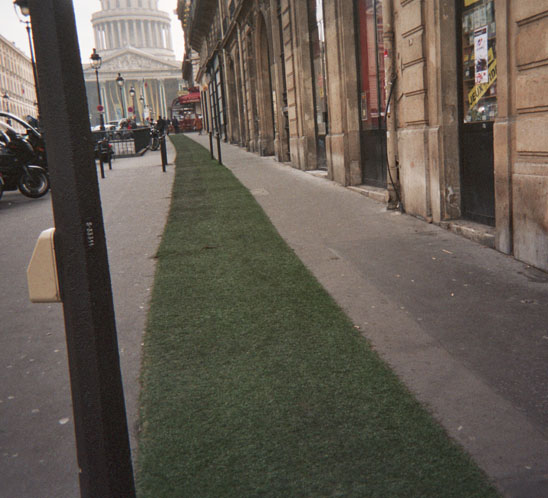
It turns out that this was a gimmick for advertising Cancer Awareness Day . I predicted that it would turn the street into a dreadful mess within 24 hours, which is what happened as can be seen from the following photographs:
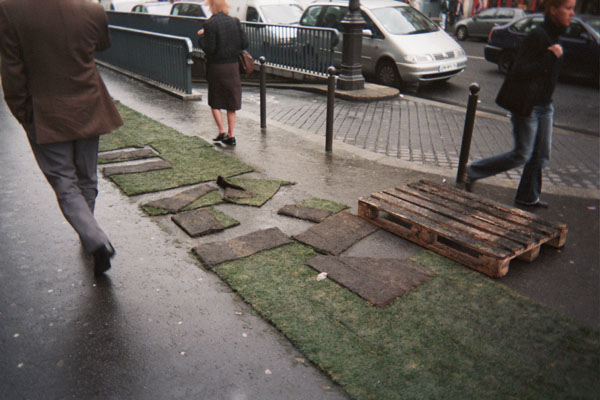
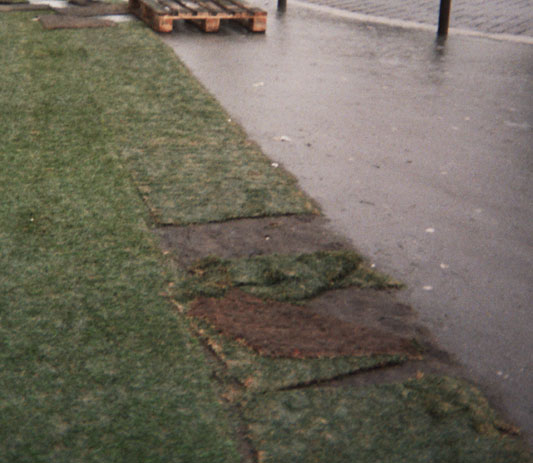
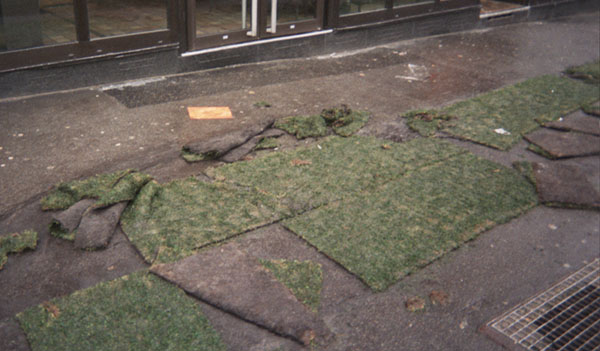
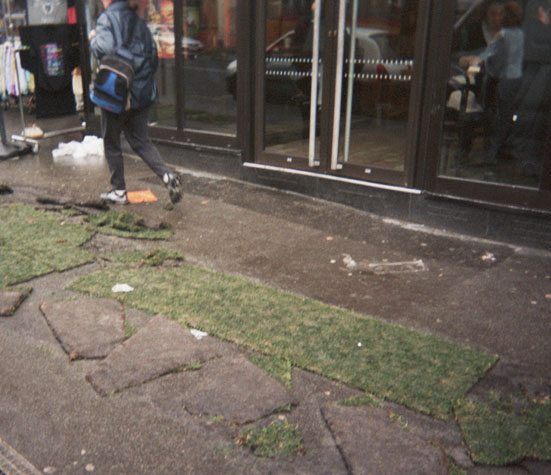
Walking up and down the street I asked people if they' d noticed when the horses went by. I received the normal distribution of responses, from loud guffaws to perplexed scowls.
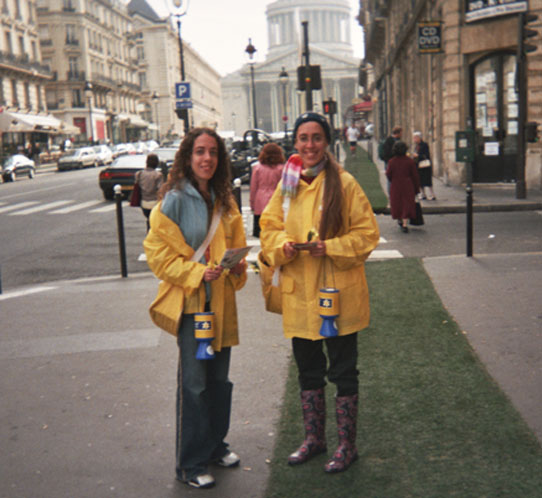
Pairs of young women in their 20's were stationed in various locations around the Fifth Arrondisement , soliciting donations for Cancer Awareness Day. I gave them what I could, though I must have appeared stingy. After being immersed in financial bewilderment for 12 days in the French capital, I instinctively clutched at every centime.
At the Curie Museum later that afternoon I walked by a table where 3 middle aged sat collecting donations for the same cause. I calculated that I could be a bit more generous this time. For my contribution I received a pin holding a paper daffodil. This was pinned next to my No War button where it stayed for the rest of the day.
I'd picked up a publicity/information booklet, a city publication vaunting the attractions of the 5th Arrondisement: a most prestigious swath of real estate!! In it one finds the Sorbonne, the Pantheon, Shakespeare and Company, the Jardins du Luxembourg, the Jardin des Plantes, the Ecole Louis-le-Grand, the Ecole Normale Superieure, the Ecole Polytechnique, the research labs of the Sorbonne along the rue d'Ulm, the bohemian haunts of the rue Mouffetard, and much else besides. All of the museums in the 5th were listed and given brief descriptions, inspiring me to spend the rest of the afternoon visiting them.
In the immediate neighborhood were the Oceanographic Institute Museum, the Curie Museum, the art museum in the Palais du Luxembourg and a few others. The art museum in the Luxembourg Palace awaits another trip. A visit to the "Police Museum" was planned, but the days of May 1968 still leave bitter memories, and it slipped my mind as I walked past it.
The Oceanographic Museum was a frank disappointment. It's a poor excuse for an aquarium, most of the "fish" are plastic models (including a life-sized coelacanth); its only real attraction is a film about Jacques Costeau and his bathyscaph. I saw the same film later this summer at the Woods Hole Oceanographic Institution.
The Curie Museum however is well worth a visit. I asked the girls at the reception desk if the tour guide would talk about the disgraceful treatment Paris meted out to Marie Curie in the affair of Paul Langevin. No, they said, Paris is very ashamed of its behavior during that episode and would not want it generally known. The tour was given by a middle-aged woman in a black dress in a charming yet comprehensible version of English.
The Institute is located in the research laboratory used by Pierre and Marie Curie during their lifetimes. Everything on the premises is a replica, the originals having been thoroughly contaminated by radiation over the years. A single piece of paper, taken from a notebook, remains, protected by thick glass in a case hanging from the wall. The guide passed a Geiger Counter over the page. The loud scintillation of clicks told us that three-quarters of a century had done little to diminish its radioactivity.
The Musee de l Assistance Publique (Museum of Welfare!) is on the quais of the left bank of the Seine, about 6 blocks from Shakespeare and Company. Situated inside the site of a centuries-old hospital, it turned out to be a museum devoted to the history of the charity hospitals in Paris, documented with manuscripts, paintings, items of clothing, surgical instruments, medical equipment and furniture .The earliest ones were established by royal charter in the year 660 AD !
Throughout the Middle Ages, given that prayer was just about the only remedy available to the seriously ill, these were essentially religious institutions. The transition to real hospitals in the modern sense began in the 18th century. Artifacts from the Middle Ages take up the 2nd and 3rd floors. Those on the ground floor date from the 18th, 19th and 20th centuries and the contemporary period. Videotapes shown in a room at the back contain interviews with the staff of pediatric hospitals in poor neighborhoods .
Every Sunday evening a crowd gathers in the drawing-room on the 3rd floor above Shakespeare & Company for tea and conversation. George Whitman has been holding these salons since the bookstore opened in the 50's. One always finds interesting people there from just about everywhere, globe-trotting writers, journalists, book-lovers and others. (Photos) George Whitman and his daughter Sylvia invited me and a Norwegian novelist and his family, to stay on afterwards for dinner. The novelist spoke knowledgeably about Henrik Ibsen, a topic of interest to me in connection with my analysis of Little Eyolf in last year's Ferment. He made the interesting observation that Scandinavian writers and artists were made welcome in Berlin in the 19th century because the German tradition was rich in composers but poor in authors and artists. ( Maybe: England has never been distinguished in music, but that didn't make London more receptive to composers. )
A few hours later, around 8 o' clock, I ended up in the reading room on the second floor, on a bench by the window at the front looking out onto Notre-Dame and the Seine. As the bells rang out from Notre-Dame in polyphonic echoing choirs, I listened to Messaien's "Quartet for the End of Time" on my Walkman tape recorder. Quite an experience.
Monday , March 22:
At 10:30 I attended a second lecture on music theory given by Guerino Mazzola at the Ecole Normale Superieure.
At 4 that evening I delivered my own paper in the studios of IRCAM. It can be read at Associative Harmony